# Data
library(diversedata) # Diverse Data Hub data set
library(tidyverse)
library(VIM)
library(gridExtra)
library(mice)Global Rights Data
Use Binder to explore and run this dataset and analysis interactively in your browser with R. Ideal for students and instructors to run, modify, and test the analysis in a live JupyterLab environment—no setup needed.
About the Data
This data set provides yearly, country-level information on LGBTQ+ rights, economic indicators, and education spending from 2001 to 2023. It is compiled from Our World in Data, with primary sources including Equaldex, the World Bank, and other open-access data sets.
The data enables cross-country and temporal comparisons of LGBTQ+ rights and economic/education metrics, exploration of relationships between rights and economic development, and identification of regional and temporal trends.
Amid ongoing challenges to LGBTQ+ rights worldwide, this dataset supports analysis, awareness, and advocacy for their protection.
Download
Metadata
Variables
| Variable Name | Role | Type | Description | Units | Missing Values |
|---|---|---|---|---|---|
year |
ID | Integer | Year the data was recorded. | Year | No |
country |
ID | String | Country name | - | No |
country-code |
ID | String | ISO 3-letter country code | - | Yes |
gdp-per-capita |
Feature | Numeric | Gross Domestic Product per capita | International $ | Yes |
education-spending-gdp |
Feature | Numeric | Government education spending as a percentage of GDP | % | Yes |
same-sex-marriage |
Target | Categorical | Legal status of same-sex marriage (e.g., “Legal”, “Varies by region”, “Unecognized”) | - | Yes |
lgbtq-censorship |
Feature | Categorical | Whether LGBTQ+ content is censored or restricted | - | Yes |
employment-discrimination |
Feature | Categorical | Whether anti-discrimination protections exist for LGBTQ+ individuals in employment | - | Yes |
gender-affirming-care |
Feature | Categorical | Availability and legal access to gender-affirming healthcare | - | Yes |
legal-gender |
Feature | Categorical | Whether legal gender can be changed and under what conditions (e.g., “Legal, no restrictions”, “Ambiguous”) | - | Yes |
Key Features of the Data Set
Each row represents a single country’s record for a specific year and includes information such as GDP per capita, education spending, and the legal status of various LGBTQ+ rights and protections.
- Identifiers (
year,country,country-code) – Year of observation, country name, and ISO code. - Economic and education metrics (
gdp-per-capita,education-spending-gdp) – GDP per capita (constant international-$) and government expenditure on education (% of GDP). - Marriage rights (
same-sex-marriage) – Legal status of same-sex marriage. - Censorship policies (
lgbtq-censorship) – Whether LGBTQ+ topics are censored. - Anti-discrimination laws (
employment-discrimination) – Protections against discrimination in employment based on sexual orientation or gender identity. - Healthcare access (
gender-affirming-care) – Legal and medical access to gender-affirming care. - Legal gender recognition (
legal-gender) – Rights around changing one’s legal gender marker.
Purpose and Use Cases
This data set is designed to support analysis of:
Global trends in LGBTQ+ rights over time
Associations between legal protections and economic or educational indicators
Regional disparities in access to gender-affirming care and anti-discrimination laws
The relationship between policy environments and broader measures of social inclusion
Temporal changes in legal recognition of same-sex marriage and gender identity
It enables cross-country comparisons and longitudinal analysis using harmonized data from trusted open-access sources.
Case Study
Objective
Which variables in the data set contain missing values, and how can we handle them appropriately to ensure a complete and unbiased analysis?
This case study explores patterns of missing data in a global LGBTQ+ rights data set that includes economic and legal indicators such as GDP per capita, education spending. Using a variety of visualization tools, we aim to identify where and how missing values occur across different variables.
Rather than ignoring or arbitrarily removing incomplete data, we apply imputation techniques to fill missing values.
Analysis
Loading Libraries
import diversedata as dd
import pandas as pd
import numpy as np
import altair as alt
import matplotlib.pyplot as plt
from sklearn.experimental import enable_iterative_imputer # no quality assurance
from sklearn.impute import IterativeImputer
from IPython.display import Markdown
alt.data_transformers.disable_max_rows()1. Data Cleaning & Processing
global_rights <- globalrights
# Select and clean variables (excluding marriage from transformation)
cleaned_rights <- global_rights |>
select(
country,
year,
`gdp-per-capita`,
`education-spending-gdp`,
`same-sex-marriage`,
`lgbtq-censorship`,
`employment-discrimination`,
`gender-affirming-care`,
`legal-gender`
) |>
as.data.frame()
# Rename columns
colnames(cleaned_rights) <- c(
"country", "year", "gdp_per_capita", "edu_spend", "same_sex_marriage",
"lgbtq_censorship", "employment", "affirming_care", "legal_gender"
)global_rights = dd.load_data("globalrights")
# Select and clean variables (excluding marriage from transformation)
cleaned_rights = global_rights[
[
"country",
"year",
"gdp-per-capita",
"education-spending-gdp",
"same-sex-marriage",
"lgbtq-censorship",
"employment-discrimination",
"gender-affirming-care",
"legal-gender",
]
]
# Rename columns
cleaned_rights.columns = [
"country",
"year",
"gdp_per_capita",
"edu_spend",
"same_sex_marriage",
"lgbtq_censorship",
"employment",
"affirming_care",
"legal_gender",
]2. Aggregation Plots
The first fundamental question to ask is: which variables contain missing values, and how many observations are affected? Aggregation plots are a useful tool to quickly summarize and visualize the extent of missingness across all variables in the data set.
Please note that :
Each row in the plot represents a unique pattern of missingness across your variables. For example, one row might show only
gdp-per-capitais missing and another might showedu_spendandemploymentare missing together.The height of each bar on the left indicates the number (or proportion) of rows in our data that match that missing pattern.
# Visualize missing values across all variables
invisible(
capture.output(
aggr(
cleaned_rights,
numbers = TRUE,
prop = c(TRUE, FALSE),
sortVars = TRUE,
cex.axis = 0.5,
las = 2, # vertical labels
gap = 2,
col = c("gray85", "skyblue"),
ylab = c("Missing Data (proportion)", "Missing Data Pattern")
)
)
)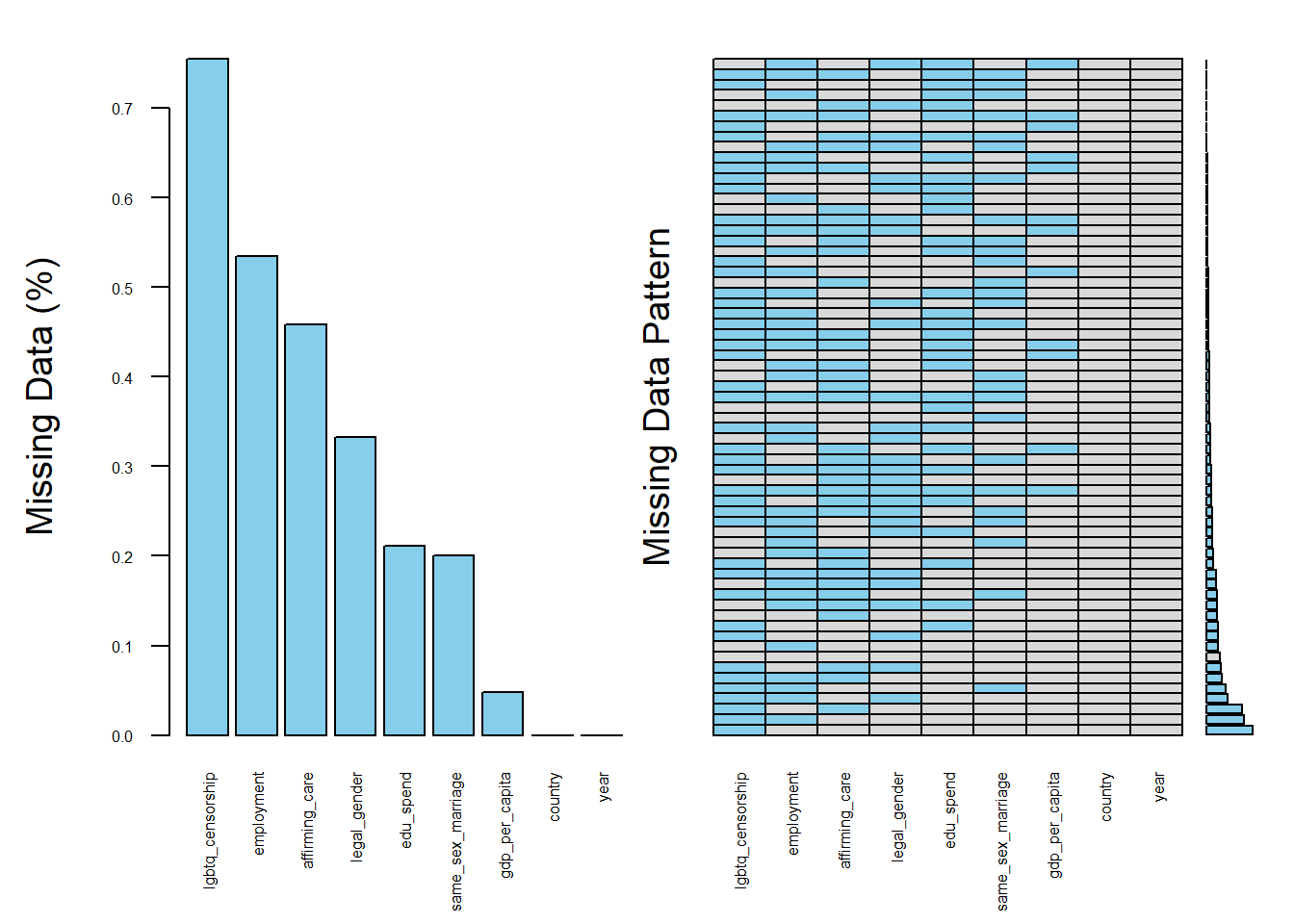
missing_prop = (
cleaned_rights.isnull()
.mean()
.reset_index()
.rename(columns={"index": "variable", 0: "missing_prop"})
)
alt.Chart(missing_prop).mark_bar().encode(
x=alt.X("variable").sort("-y").title("Variable").axis(alt.Axis(labelAngle=-45)),
y=alt.Y("missing_prop").title("Missing Data Proportion"),
tooltip=["variable", "missing_prop"],
).properties(width=400, height=300)Code
pattern_df = cleaned_rights.isnull().astype(int)
pattern_df = (
pattern_df.groupby(by=pattern_df.columns.to_list())
.size()
.reset_index(name="count")
.sort_values(by="count")
.reset_index(drop=True)
)
pattern_df = pattern_df[
[
"lgbtq_censorship",
"employment",
"affirming_care",
"legal_gender",
"edu_spend",
"same_sex_marriage",
"gdp_per_capita",
"country",
"year",
"count",
]
]
pattern_df_no_count = pattern_df.drop(columns=["count"])
# Create plot
fig, (ax1, ax2) = plt.subplots(
1, 2, figsize=(12, 8), gridspec_kw={"width_ratios": [4, 1]}
)
# Put data into a matrix for pattern plot
pattern_matrix = pattern_df_no_count.astype(bool).to_numpy()
# Colors
colors = ["lightgrey", "skyblue"]
cmap = plt.matplotlib.colors.ListedColormap(colors)
# Pattern plot
im = ax1.imshow(pattern_matrix, cmap=cmap, aspect="auto", interpolation="nearest")
# Labels
ax1.set_xlabel("Variable")
ax1.set_ylabel("Missing Data Pattern")
ax1.set_xticks(range(len(pattern_df_no_count.columns)))
ax1.set_xticklabels(pattern_df_no_count.columns, rotation=45, ha="right")
ax1.set_yticks([]);
ax1.set_yticklabels([]);
# Grid
ax1.set_xticks(np.arange(len(pattern_df_no_count.columns)) - 0.5, minor=True)
ax1.set_yticks(np.arange(len(pattern_df_no_count.index)) - 0.5, minor=True)
ax1.grid(which="minor", color="white", linewidth=2)
# Count bar chart
counts = pattern_df["count"]
y_positions = np.arange(len(pattern_df_no_count.index))
bar_height = 0.8
bars = ax2.barh(y_positions, counts, height=bar_height, color="skyblue", align="center")
# Labels
ax2.set_xlabel("Count")
ax2.set_ylabel("")
ax2.set_yticks(y_positions)
ax2.set_yticklabels([])
# Set y-limits of bar chart to be the same as the pattern plot
ax2.set_ylim(ax1.get_ylim());
plt.tight_layout()
plt.show()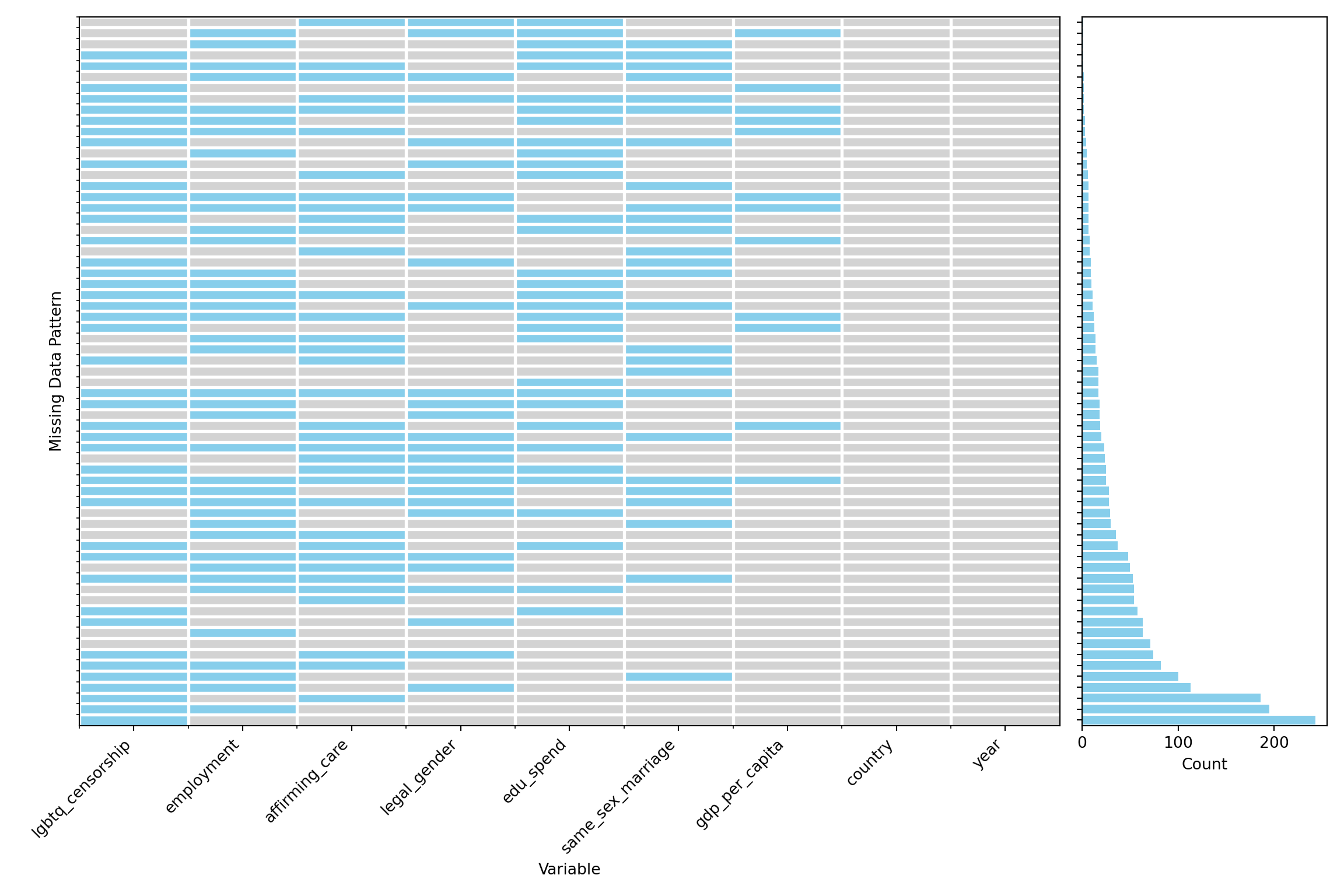
The aggregation plot provides a clear overview of missingness across variables in the data set. From this visualization, it is evident that several categorical variables particularly lgbtq-censorship, employment, and affirming-care contain substantial amounts of missing data. Among the continuous variables, education spending (edu-spend) stands out as having more missing values than gdp-per-capita, which may reflect inconsistencies in government reporting or data availability across countries. Many variables in this data set have missing values, so handling missing data is an important step in preparing the data.
Given the extent of missing data observed in the aggregation plot, we will take a closer look at selected variables to better understand the underlying patterns of missingness. Specifically, we focus on the following variables:
gdp-per-capitaandedu-spend, as key continuous indicators of national economic and educational investment. These variables are central to many of the analyses in this data set and missingness here may influence statistical outcomes if not properly addressed.same-sex-marriagerepresents a key dimension of legal recognition for LGBTQ+ individuals. This categorical variable shows substantial missingness, which may reflect patterns tied to reporting practices or regional legal disparities in the recognition of same-sex unions. It includes seven categories that capture the varying legal statuses across countries: Banned, Civil union or other partnership, Unrecognized, Unregistered cohabitation, Legal, Varies by region, and Foreign same-sex marriages recognized only.
3. Spinogram and Spineplot
So far, we have gained a high-level overview of missingness across the data set. To dig deeper, we now examine how missing values in one variable relate to the categories of another. This helps us understand whether missingness may be random or related to other features in the data.
The function spineMiss() from the {VIM} R package is used for this purpose. It produces a spineplot, a type of bar chart that visualizes the distribution of missing vs. non-missing values in a variable (in this case, gdp) across the levels of a categorical variable (in this case, same-sex-marriage).
By running spineMiss(cleaned_rights[, c("marriage", "gdp")]), we create a plot that shows, for each category of same-sex marriage recognition (e.g., Legal, Civil Union, Not Recognized), the proportion of observations where GDP is missing versus observed. This plot can also be replicated in Python using the pandas and altair packages.
This visualization allows us to assess whether missing GDP values are evenly distributed across marriage groups (which might suggest MCAR: Missing Completely at Random), or if they are more prevalent in certain categories (which could suggest MAR: Missing at Random). It’s a helpful diagnostic tool to explore whether the missingness in gdp-per-capita is associated with legal recognition of same-sex marriage, which is crucial before deciding how to impute or model the data.
Please note that, based on Flexible Imputation of Missing Data by Stef van Buuren (2018), you can find the definitions as follows:
MCAR (Missing Completely at Random): The probability of missingness is unrelated to any observed or unobserved data. In other words, missing data occur entirely at random.
MAR (Missing at Random): The probability of missingness may depend on observed data but not on the missing values themselves. For example, GDP might be missing more often in countries without same-sex marriage laws, but not because of the GDP value itself.
MNAR (Missing Not at Random): The probability of missingness depends on the value of the missing data itself. For example, countries with very low GDP might be less likely to report it.
# Visualize missingness in GDP per capita across same-sex marriage legal status categories
par(mar = c(15, 4, 2, 2) + 0.1)
spineMiss(cleaned_rights[, c("same_sex_marriage", "gdp_per_capita")],
col = c("gray85", "skyblue"),
cex.axis = 0.7,
las = 2,
xlab = "",
ylab = "")
mtext("Same Sex Marriage Status", side = 1, line = 13)
mtext("Proportion of Missing/Observed", side = 2, line = 3, adj = 1)
mtext("Missingness of GDP per Capita by Same-Sex Marriage Status", line = 1)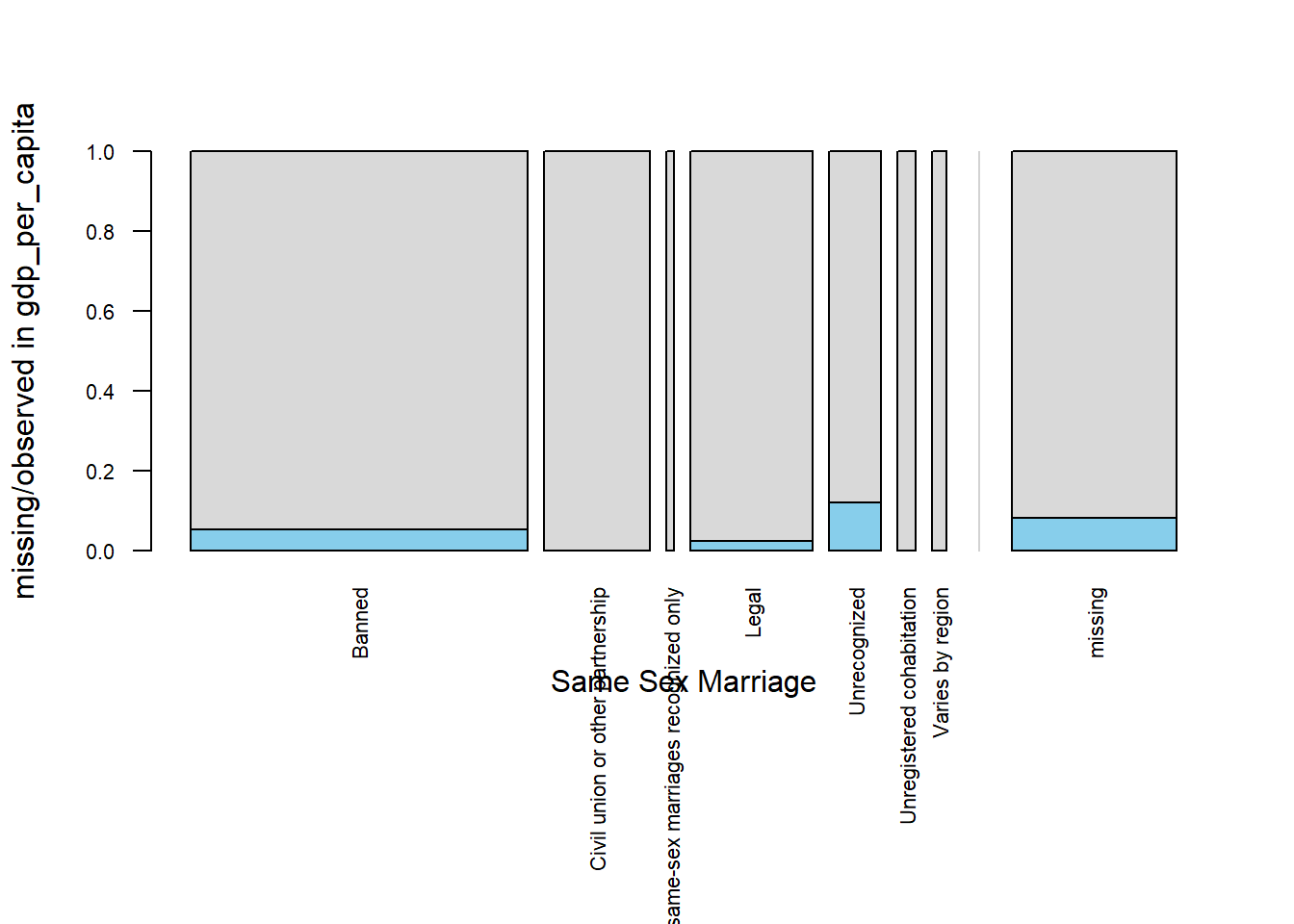
# Visualize missingness in GDP per capita across same-sex marriage legal status categories
spino_data = cleaned_rights.copy()
spino_data["gdp_missing"] = spino_data["gdp_per_capita"].isnull()
alt.Chart(spino_data).mark_bar().encode(
x=alt.X("same_sex_marriage:N")
.title("Same Sex Marriage Status")
.axis(alt.Axis(labelAngle=-45)),
y=alt.Y("count()").stack("normalize").title("Percent of Missingness/Observed"),
color=alt.Color("gdp_missing:N")
.scale(alt.Scale(domain=[True, False], range=["skyblue", "lightgrey"]))
.legend(None),
tooltip=["same_sex_marriage", "gdp_missing", "count()"],
).properties(
width=400,
height=300,
title="Missingness of GDP per Capita by Same-Sex Marriage Status"
)The spine plot shows that missing values in gdp-per-capita are not distributed evenly across the levels of same-sex-marriage recognition. Between seven categories, missingness is most frequent in countries where same-sex marriages are Unrecognized, followed by those where same-sex marriage is Banned, and then in countries where it is Legal.
This pattern suggests that the missingness in GDP is likely not completely at random, and may be associated with marriage recognition status, indicating a Missing At Random (MAR) mechanism. Recognizing this pattern is important, as it can guide the selection of appropriate imputation strategies that account for such relationships.
# Visualize missingness in education spending across same-sex marriage legal status categories
par(mar = c(15, 4, 2, 2) + 0.1)
spineMiss(cleaned_rights[, c("same_sex_marriage", "edu_spend")],
col = c("gray85", "skyblue"),
cex.axis = 0.7,
las = 2,
xlab = "",
ylab = "")
mtext("Same Sex Marriage Status", side = 1, line = 13)
mtext("Proportion of Missing/Observed", side = 2, line = 3, adj = 1)
mtext("Missingness of Education Spending by Same-Sex Marriage Status", line = 1)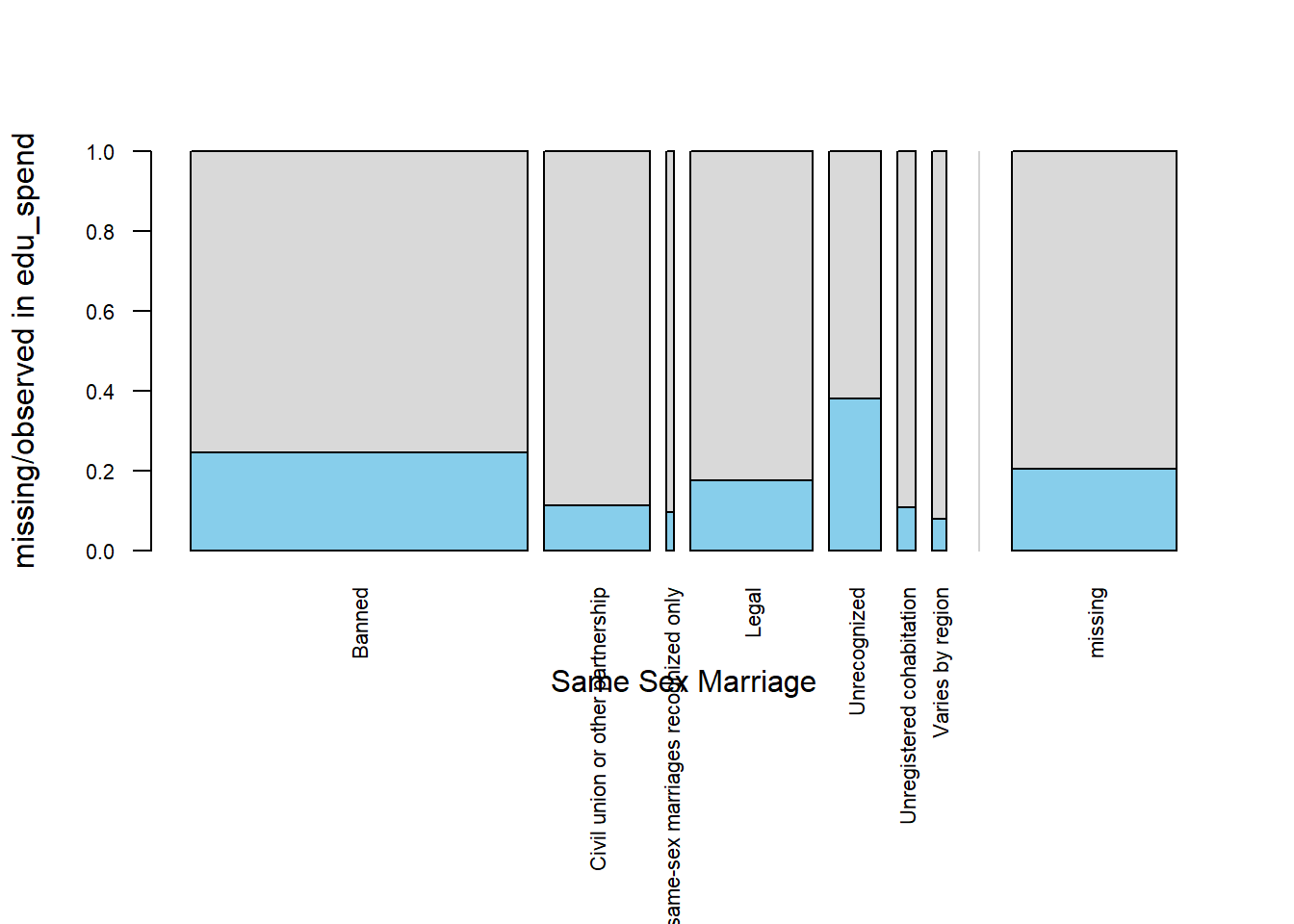
spino_data["edu_missing"] = spino_data["edu_spend"].isnull()
alt.Chart(spino_data).mark_bar().encode(
x=alt.X("same_sex_marriage:N")
.title("Same Sex Marriage Status")
.axis(alt.Axis(labelAngle=-45)),
y=alt.Y("count()").stack("normalize").title("Percent of Missingness/Observed"),
color=alt.Color("edu_missing:N")
.scale(alt.Scale(domain=[True, False], range=["skyblue", "lightgrey"]))
.legend(None),
tooltip=["same_sex_marriage", "edu_missing", "count()"],
).properties(
width=400,
height=300,
title="Missingness of Education Spending by Same-Sex Marriage Status",
)The spine plot for edu-spend across same-sex-marriage categories reveals that missing values are present in all levels of marriage recognition, unlike gdp, where missingness was more concentrated. Again between seven categories, missingness is most frequent in countries where same-sex marriages are Unrecognized, followed by those where same-sex marriage is Banned, and then in countries where it is Legal. We can also see that the Civil union or other partnership category has missing values
This widespread but uneven distribution suggests that the missingness in education spending is likely not completely at random (MCAR). Instead, it may be Missing At Random (MAR), as the probability of missing values appears to vary with observed levels of legal recognition. This pattern underscores the importance of considering contextual legal factors when handling missing values for edu-spend, as they may be informative and should influence imputation choices.
4. Multivariate Imputation by Chained Equations (MICE) using PMM
We used MICE with predictive mean matching (PMM) because it is well-suited to data sets with multiple partially missing variables, allows for realistic value imputation, and accommodates the MAR mechanism observed in o
Through earlier visualizations (like spineMiss and mosaicMiss), we observed that the missing values in gdp and edu_spend depend on other variables (e.g., marriage status). This suggests the data are Missing at Random (MAR) where imputation models should account for relationships between variables.
We used Predictive Mean Matching (PMM) to impute missing values in continuous variables like GDP and education spending. This method ensures that the imputed values are realistic and drawn from the actual data distribution, avoiding extreme or implausible results like negative GDP. Because these variables are often skewed, PMM offers a more robust alternative to linear regression.
To handle multiple variables with missing values, we applied the MICE algorithm, which builds a separate model for each incomplete variable using relevant predictors like marriage status, employment protection, and legal gender. This approach allows for flexible and iterative imputation, especially effective when missingness is spread across several variables.
Finally, MICE generates multiple imputed data sets, which supports transparent and reproducible analysis while accounting for uncertainty in the missing data.
impute_df <- cleaned_rights |>
select(gdp_per_capita, edu_spend, same_sex_marriage, lgbtq_censorship, employment, affirming_care, legal_gender)
impute_df <- impute_df |>
mutate(
marriage = as.factor(same_sex_marriage),
censorship = as.factor(lgbtq_censorship),
employment = as.factor(employment),
affirming_care = as.factor(affirming_care),
legal_gender = as.factor(legal_gender)
)
set.seed(123)
imputed <- mice(impute_df, method = "pmm", m = 5)
iter imp variable
1 1 gdp_per_capita edu_spend employment affirming_care legal_gender marriage censorship
1 2 gdp_per_capita edu_spend employment affirming_care legal_gender marriage censorship
1 3 gdp_per_capita edu_spend employment affirming_care legal_gender marriage censorship
1 4 gdp_per_capita edu_spend employment affirming_care legal_gender marriage censorship
1 5 gdp_per_capita edu_spend employment affirming_care legal_gender marriage censorship
2 1 gdp_per_capita edu_spend employment affirming_care legal_gender marriage censorship
2 2 gdp_per_capita edu_spend employment affirming_care legal_gender marriage censorship
2 3 gdp_per_capita edu_spend employment affirming_care legal_gender marriage censorship
2 4 gdp_per_capita edu_spend employment affirming_care legal_gender marriage censorship
2 5 gdp_per_capita edu_spend employment affirming_care legal_gender marriage censorship
3 1 gdp_per_capita edu_spend employment affirming_care legal_gender marriage censorship
3 2 gdp_per_capita edu_spend employment affirming_care legal_gender marriage censorship
3 3 gdp_per_capita edu_spend employment affirming_care legal_gender marriage censorship
3 4 gdp_per_capita edu_spend employment affirming_care legal_gender marriage censorship
3 5 gdp_per_capita edu_spend employment affirming_care legal_gender marriage censorship
4 1 gdp_per_capita edu_spend employment affirming_care legal_gender marriage censorship
4 2 gdp_per_capita edu_spend employment affirming_care legal_gender marriage censorship
4 3 gdp_per_capita edu_spend employment affirming_care legal_gender marriage censorship
4 4 gdp_per_capita edu_spend employment affirming_care legal_gender marriage censorship
4 5 gdp_per_capita edu_spend employment affirming_care legal_gender marriage censorship
5 1 gdp_per_capita edu_spend employment affirming_care legal_gender marriage censorship
5 2 gdp_per_capita edu_spend employment affirming_care legal_gender marriage censorship
5 3 gdp_per_capita edu_spend employment affirming_care legal_gender marriage censorship
5 4 gdp_per_capita edu_spend employment affirming_care legal_gender marriage censorship
5 5 gdp_per_capita edu_spend employment affirming_care legal_gender marriage censorshipThe IterativeImputer estimator by scikit-learn is still experimental for now: the predictions and the API might change without any deprecation cycle.
It was inspired by the R MICE package but only returns a single imputation. So, we have applied it repeatedly with different random seeds to obtain multiple imputations. More information can be found here and here.
# subset the columns
df_to_impute = cleaned_rights[
[
"gdp_per_capita",
"edu_spend",
"same_sex_marriage",
"lgbtq_censorship",
"employment",
"affirming_care",
"legal_gender",
]
].copy()
# convert categorical variables to category dtype
# and make numeric encodings for imputation
categorical_cols = [
"same_sex_marriage",
"lgbtq_censorship",
"employment",
"affirming_care",
"legal_gender",
]
for col in categorical_cols:
df_to_impute[col] = (
df_to_impute[col].astype("category").cat.codes.replace(-1, np.nan)
)
# run multiple imputations (predictive mean matching style) to produce 5 imputed datasets
imputed_dfs = []
for random_state in range(
0, 500, 100
): # set random state for each iteration for reproducibility
imputer = IterativeImputer(random_state=random_state, sample_posterior=True)
imputed_array = imputer.fit_transform(df_to_impute)
imputed_df = pd.DataFrame(imputed_array, columns=df_to_impute.columns)
imputed_dfs.append(imputed_df)5. Visual Comparison for Before and After Imputation
plot_before <- densityplot(~ gdp_per_capita, data = cleaned_rights,
main = "Distribution of GDP (Original Data)",
xlab = "GDP per Capita")
plot_after <- densityplot(imputed, ~ gdp_per_capita,
main = "Distribution of GDP (Imputed vs. Observed)",
xlab = "GDP per Capita")
# Arrange the two plots vertically
grid.arrange(plot_before, plot_after, ncol = 1, heights = c(1, 1))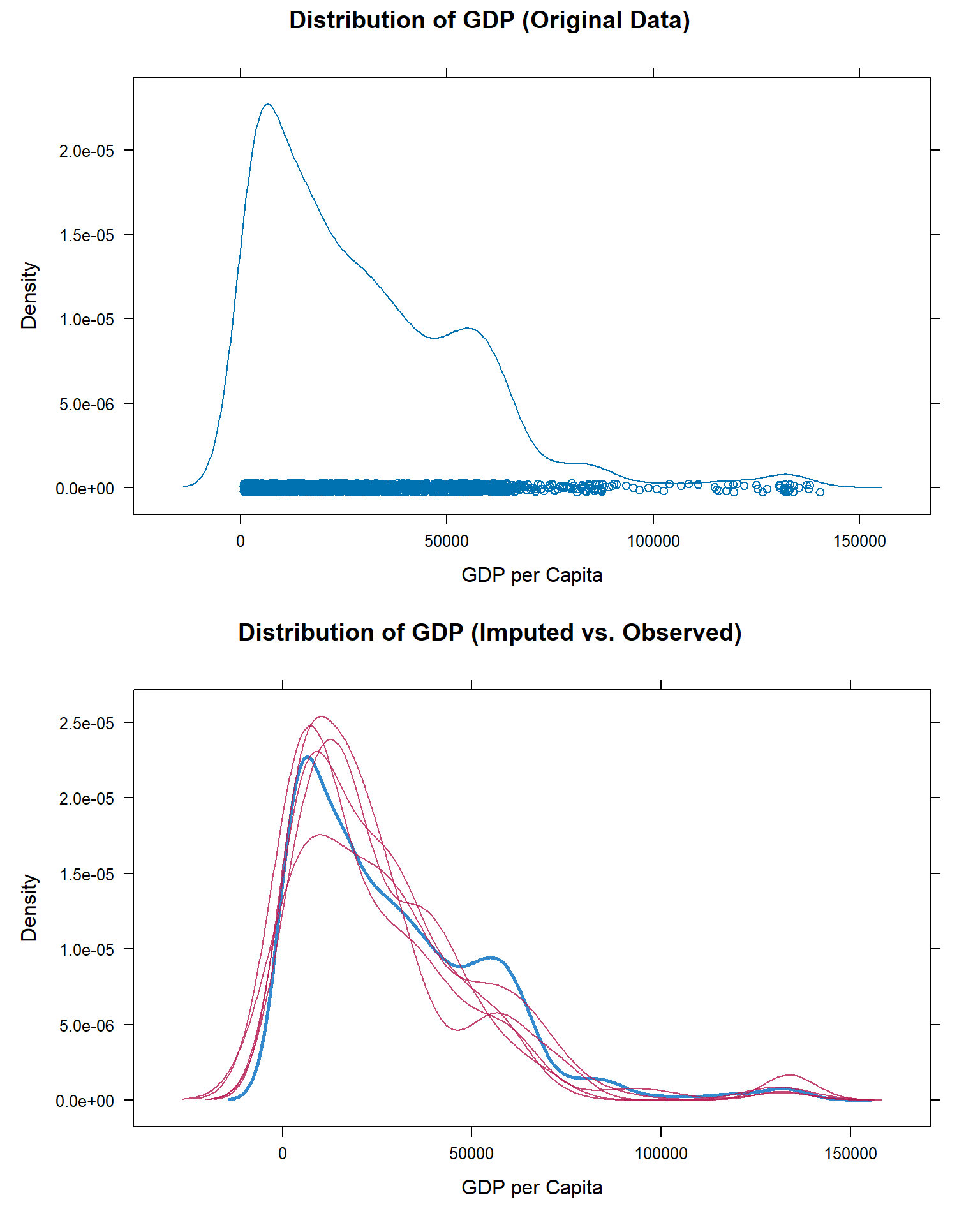
all_imputed_dfs = (
pd.concat(imputed_dfs, keys=range(1, 6))
.reset_index(names=["imputation_iteration", "old_index"])
.drop(columns="old_index")
)
df_to_impute["imputation_iteration"] = "Original Observed Data"
all_dfs = pd.concat([df_to_impute, all_imputed_dfs])
observed_gdp_density = alt.Chart(cleaned_rights).transform_density(
"gdp_per_capita",
as_=["gdp_per_capita", "density"],
).mark_line(opacity=0.5).encode(
x=alt.X("gdp_per_capita").title("GDP per Capita"),
y=alt.Y("density:Q").stack(False).title("Density"),
).properties(
title="Distribution of GDP (Original Data)", width=600, height=400
)
observed_gdp_point = alt.Chart(cleaned_rights).mark_tick(opacity=0.5).encode(
x=alt.X("gdp_per_capita"),
y=alt.datum(0)
)
observed_gdp = observed_gdp_point + observed_gdp_density
imputed_gdp = alt.Chart(all_dfs).transform_density(
"gdp_per_capita",
groupby=["imputation_iteration"],
as_=["gdp_per_capita", "density"],
).mark_line(opacity=0.5).encode(
x=alt.X("gdp_per_capita").title("GDP per Capita"),
y=alt.Y("density:Q").stack(False).title("Density"),
color=alt.Color("imputation_iteration:N").title("Imputation Iteration"),
tooltip=alt.Tooltip(["imputation_iteration"]).title("Imputation Iteration"),
).properties(
title="Distribution of GDP (Imputed vs. Observed)", width=600, height=400
)
(observed_gdp & imputed_gdp).resolve_scale(x="shared", y="shared").resolve_legend(
color="independent"
)plot_before <- densityplot(~ edu_spend, data = cleaned_rights,
main = "Distribution of Government Education Spending (Original Data)",
xlab = "Government Education Spending as a Percentage of GDP")
plot_after <- densityplot(imputed, ~ edu_spend,
main = "Distribution of Government Education Spending (Imputed vs. Observed)",
xlab = "Government Education Spending as a Percentage of GDP")
# Arrange the two plots vertically
grid.arrange(plot_before, plot_after, ncol = 1, heights = c(1, 1))
observed_edu_density = alt.Chart(cleaned_rights.dropna(subset=["edu_spend"])).transform_density(
"edu_spend",
as_=["edu_spend", "density"],
).mark_line(opacity=0.5).encode(
x=alt.X("edu_spend").title("Government Education Spending as a Percentage of GDP"),
y=alt.Y("density:Q").stack(False).title("Density"),
).properties(
title="Distribution of Government Education Spending (Original Data)", width=600, height=400
)
observed_edu_point = alt.Chart(cleaned_rights).mark_tick(opacity=0.5).encode(
x=alt.X("edu_spend"),
y=alt.datum(0)
)
observed_edu = observed_edu_point + observed_edu_density
imputed_edu = alt.Chart(all_dfs.dropna(subset=["edu_spend"])).transform_density(
"edu_spend", groupby=["imputation_iteration"], as_=["edu_spend", "density"]
).mark_line(opacity=0.5).encode(
x=alt.X("edu_spend").title("Government Education Spending as a Percentage of GDP"),
y=alt.Y("density:Q").stack(False).title("Density"),
color=alt.Color("imputation_iteration:N").title("Imputation Iteration"),
tooltip=alt.Tooltip(["imputation_iteration"]).title("Imputation Iteration"),
).properties(
title="Distribution of Government Education Spending (Imputed vs. Observed)",
width=600,
height=400,
)
(observed_edu & imputed_edu).resolve_scale(x="shared", y="shared").resolve_legend(
color="independent"
)Discussion
Missing data can significantly hinder analysis, especially when it affects key economic indicators like GDP per capita and education spending. In this case study, we addressed missingness in both variables using Multiple Imputation by Chained Equations (MICE) with Predictive Mean Matching (PMM).
By including categorical predictors such as legal gender recognition, employment protection, marriage equality, and censorship laws, we aimed to generate imputations that reflect realistic values consistent with each country’s broader policy environment. The use of PMM ensured that imputed values were drawn from observed data points, preserving the original distribution and avoiding implausible values (e.g., negative GDP or unrealistic education spending).
We imputed both variables simultaneously within the same model, allowing the algorithm to borrow strength across variables and iterations. This approach reflects a more robust and context-aware method than imputing variables separately or using simple strategies like mean substitution.
Comparing the density plots of the original and imputed data revealed that the imputed values align well with the observed data distribution, suggesting that the imputations are not introducing substantial bias. This strengthens the reliability of subsequent statistical analyses such as ANOVA, regression modeling, or equity comparisons that rely on complete data sets.
However, there are some limitations to consider. While MICE with PMM preserves distributional properties, it still assumes that the data are missing at random (MAR), which may not hold true in all contexts particularly when data availability is tied to political or economic instability. Moreover, the inclusion of policy indicators as predictors helps contextualize imputations but may also introduce circular reasoning if those same indicators are later used as outcomes in analysis. Future work could explore sensitivity analyses to assess how different imputation models affect results or incorporate external data sources to validate imputed values. Addressing these limitations would further strengthen the robustness and credibility of equity-focused policy research.
Attribution
This analysis uses data compiled and curated from Our World in Data, an open-access initiative that aggregates global development indicators. The variables used in this analysis include economic and policy-related measures across 91 countries from 2000 to 2023.
Data sources include:
- GDP per Capita: Our World in Data – Economic Growth
- Education Spending (% of GDP): Our World in Data – Education Expenditure
- LGBTQ+ Rights Indicators:
All data is used under the terms of the Creative Commons BY license. Please refer to Our World in Data – Licensing for more details.
Citation:
Our World in Data. Various data sets compiled and maintained by the Global Change Data Lab.
https://ourworldindata.org